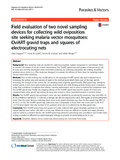| dc.contributor.author | Dugassa, S | |
| dc.contributor.author | Lindh, JM | |
| dc.contributor.author | Lindsay, SW | |
| dc.contributor.author | Fillinger, U | |
| dc.date.accessioned | 2017-05-15T09:23:17Z | |
| dc.date.available | 2017-05-15T09:23:17Z | |
| dc.date.issued | 2016 | |
| dc.identifier.citation | Parasit Vectors. 2016 May 10;9(1):272. doi: 10.1186/s13071-016-1557-7. | en_US |
| dc.identifier.uri | https://www.ncbi.nlm.nih.gov/pubmed/27165292 | |
| dc.identifier.uri | https://parasitesandvectors.biomedcentral.com/articles/10.1186/s13071-016-1557-7 | |
| dc.identifier.uri | http://hdl.handle.net/11295/100911 | |
| dc.description.abstract | BACKGROUND:
New sampling tools are needed for collecting exophilic malaria mosquitoes in sub-Saharan Africa to monitor the impact of vector control interventions. The OviART gravid trap and squares of electrocuting nets (e-nets) were recently developed under semi-field conditions for collecting oviposition site seeking Anopheles gambiae (sensu stricto) (s.s.). This study was designed to evaluate the efficacy of these traps for sampling malaria vectors under field conditions.
METHODS:
Prior to field testing, two modifications to the prototype OviART gravid trap were evaluated by (i) increasing the surface area and volume of water in the artificial pond which forms part of the trap, and (ii) increasing the strength of the suction fan. Six sampling tools targeting gravid females (Box gravid trap, detergent-treated ponds, e-nets insect glue-treated ponds, sticky boards and sticky floating-acetate sheets) were compared under field conditions to evaluate their relative catching performance and to select a method for comparison with the OviART gravid trap. Finally, the trapping efficacy of the OviART gravid trap and the square of e-nets were compared with a Box gravid trap during the long rainy season in three household clusters in western Kenya.
RESULTS:
The OviART gravid trap prototype's catch size was doubled by increasing the pond size [rate ratio (RR) 1.9; 95 % confidence interval (CI) 1.1-3.4] but a stronger fan did not improve the catch. The square of e-nets performed better than the other devices, collecting three times more gravid Anopheles spp. than the Box gravid trap (RR 3.3; 95 % CI 1.4-7.6). The OviART gravid trap collections were comparable to those from the e-nets and 3.3 (95 % CI 1.5-7.0) times higher than the number of An. gambiae senso lato (s.l.) collected by the Box gravid trap.
CONCLUSION:
Both OviART gravid trap and squares of e-nets collected wild gravid Anopheles gambiae (s.l.) where natural habitats were within 200-400 m of the trap. Whilst the e-nets are difficult to handle and might therefore only be useful as a research device, the OviART gravid trap presents a promising new surveillance tool. Further field testing is needed in different eco-epidemiological settings to provide recommendations for its use. | en_US |
| dc.language.iso | en | en_US |
| dc.publisher | University of Nairobi | en_US |
| dc.rights | Attribution-NonCommercial-NoDerivs 3.0 United States | * |
| dc.rights.uri | http://creativecommons.org/licenses/by-nc-nd/3.0/us/ | * |
| dc.subject | Anopheles; Electrocuting net; Field study; Gravid trap; Malaria vector; Semi-field | en_US |
| dc.title | Field evaluation of two novel sampling devices for collecting wild oviposition site seeking malaria vector mosquitoes: OviART gravid traps and squares of electrocuting nets. | en_US |
| dc.type | Article | en_US |



